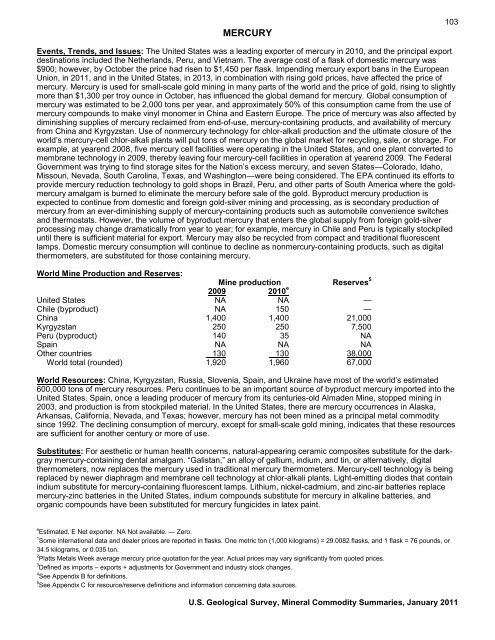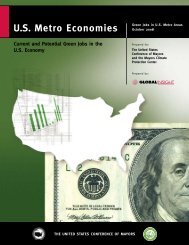MERCURY103Events, Trends, <strong>and</strong> Issues: The United States was a leading exporter of mercury in 2010, <strong>and</strong> the principal exportdestinations included the Netherl<strong>and</strong>s, Peru, <strong>and</strong> Vietnam. The average cost of a flask of domestic mercury was$900; however, by October the price had risen to $1,450 per flask. Impending mercury export bans in the EuropeanUnion, in <strong>2011</strong>, <strong>and</strong> in the United States, in 2013, in combination with rising gold prices, have affected the price ofmercury. Mercury is used for small-scale gold mining in many parts of the world <strong>and</strong> the price of gold, rising to slightlymore than $1,300 per troy ounce in October, has influenced the global dem<strong>and</strong> for mercury. Global consumption ofmercury was estimated to be 2,000 tons per year, <strong>and</strong> approximately 50% of this consumption came from the use ofmercury compounds to make vinyl monomer in China <strong>and</strong> Eastern Europe. The price of mercury was also affected bydiminishing supplies of mercury reclaimed from end-of-use, mercury-containing products, <strong>and</strong> availability of mercuryfrom China <strong>and</strong> Kyrgyzstan. Use of nonmercury technology for chlor-alkali production <strong>and</strong> the ultimate closure of theworld’s mercury-cell chlor-alkali plants will put tons of mercury on the global market for recycling, sale, or storage. Forexample, at yearend 2008, five mercury cell facilities were operating in the United States, <strong>and</strong> one plant converted tomembrane technology in 2009, thereby leaving four mercury-cell facilities in operation at yearend 2009. The FederalGovernment was trying to find storage sites for the Nation’s excess mercury, <strong>and</strong> seven States—Colorado, Idaho,Missouri, Nevada, South Carolina, Texas, <strong>and</strong> Washington—were being considered. The EPA continued its efforts toprovide mercury reduction technology to gold shops in Brazil, Peru, <strong>and</strong> other parts of South America where the goldmercuryamalgam is burned to eliminate the mercury before sale of the gold. Byproduct mercury production isexpected to continue from domestic <strong>and</strong> foreign gold-silver mining <strong>and</strong> processing, as is secondary production ofmercury from an ever-diminishing supply of mercury-containing products such as automobile convenience switches<strong>and</strong> thermostats. However, the volume of byproduct mercury that enters the global supply from foreign gold-silverprocessing may change dramatically from year to year; for example, mercury in Chile <strong>and</strong> Peru is typically stockpileduntil there is sufficient material for export. Mercury may also be recycled from compact <strong>and</strong> traditional fluorescentlamps. Domestic mercury consumption will continue to decline as nonmercury-containing products, such as digitalthermometers, are substituted for those containing mercury.World Mine Production <strong>and</strong> Reserves:Mine production Reserves 520092010 eUnited States NA NA —Chile (byproduct) NA 150 —China 1,400 1,400 21,000Kyrgyzstan 250 250 7,500Peru (byproduct) 140 35 NASpain NA NA NAOther countries 130 13038,000World total (rounded) 1,920 1,960 67,000World Resources: China, Kyrgyzstan, Russia, Slovenia, Spain, <strong>and</strong> Ukraine have most of the world’s estimated600,000 tons of mercury resources. Peru continues to be an important source of byproduct mercury imported into theUnited States. Spain, once a leading producer of mercury from its centuries-old Almaden Mine, stopped mining in2003, <strong>and</strong> production is from stockpiled material. In the United States, there are mercury occurrences in Alaska,Arkansas, California, Nevada, <strong>and</strong> Texas; however, mercury has not been mined as a principal metal commoditysince 1992. The declining consumption of mercury, except for small-scale gold mining, indicates that these resourcesare sufficient for another century or more of use.Substitutes: For aesthetic or human health concerns, natural-appearing ceramic composites substitute for the darkgraymercury-containing dental amalgam. “Galistan,” an alloy of gallium, indium, <strong>and</strong> tin, or alternatively, digitalthermometers, now replaces the mercury used in traditional mercury thermometers. Mercury-cell technology is beingreplaced by newer diaphragm <strong>and</strong> membrane cell technology at chlor-alkali plants. Light-emitting diodes that containindium substitute for mercury-containing fluorescent lamps. Lithium, nickel-cadmium, <strong>and</strong> zinc-air batteries replacemercury-zinc batteries in the United States, indium compounds substitute for mercury in alkaline batteries, <strong>and</strong>organic compounds have been substituted for mercury fungicides in latex paint.e Estimated. E Net exporter. NA Not available. — Zero.1 Some international data <strong>and</strong> dealer prices are reported in flasks. One metric ton (1,000 kilograms) = 29.0082 flasks, <strong>and</strong> 1 flask = 76 pounds, or34.5 kilograms, or 0.035 ton.2 Platts Metals Week average mercury price quotation for the year. Actual prices may vary significantly from quoted prices.3 Defined as imports – exports + adjustments for Government <strong>and</strong> industry stock changes.4 See Appendix B for definitions.5 See Appendix C for resource/reserve definitions <strong>and</strong> information concerning data sources.U.S. Geological Survey, <strong>Mineral</strong> <strong>Commodity</strong> <strong>Summaries</strong>, January <strong>2011</strong>
104MICA (NATURAL)(Data in thous<strong>and</strong> metric tons unless otherwise noted)Domestic Production <strong>and</strong> Use: Scrap <strong>and</strong> flake mica production, excluding low-quality sericite, was estimated to be53,000 tons in 2010. Mica was mined in Alabama, Georgia, North Carolina, <strong>and</strong> South Dakota. Scrap mica wasrecovered principally from mica <strong>and</strong> sericite schist <strong>and</strong> as a byproduct from feldspar, kaolin, <strong>and</strong> industrial s<strong>and</strong>beneficiation. The majority of domestic production was processed into small particle-size mica by either wet or drygrinding. Primary uses were joint compound, oil-well-drilling additives, paint, roofing, <strong>and</strong> rubber products. The valueof 2010 scrap mica production was estimated to be $7.5 million.A minor amount of sheet mica was produced in 2010 as a byproduct at a gemstone mine in Amelia, VA, <strong>and</strong> asincidental production from feldspar mining in the Spruce Pine area of North Carolina. The domestic consumingindustry was dependent upon imports to meet dem<strong>and</strong> for sheet mica. Most sheet mica was fabricated into parts forelectronic <strong>and</strong> electrical equipment.Salient Statistics—United States: 2006 2007 2008 2009 2010 eScrap <strong>and</strong> flake:Production: 1, 2Mine 110 97 84 50 53Ground 123 99 98 77 82Imports, mica powder <strong>and</strong> mica waste 45 41 27 20 27Exports, mica powder <strong>and</strong> mica waste 7 8 9 8 7Consumption, apparent 3 148 130 102 62 73Price, average, dollars per metric ton, reported:Scrap <strong>and</strong> flake 204 149 143 140 140Ground:Wet 784 683 651 651 650Dry 237 243 251 284 290Employment, mine, number NA NA NA NA NANet import reliance 4 as a percentage ofapparent consumption 26 26 18 19 27Sheet:Production, mine e ( 5 ) ( 5 ) ( 5 ) ( 5 ) ( 5 )Imports, plates, sheets, strips; worked mica;split block; splittings; other >$1.00/kg 1.77 1.95 1.90 1.51 2.10Exports, plates, sheets, strips; worked mica;crude <strong>and</strong> rifted into sheet or splittings >$1.00/kg 1.40 1.30 2.02 1.11 0.95Shipments from Government stockpile excesses ( 5 ) ( 5 ) ( 5 ) — —Consumption, apparent0.380.68 ( 6, 7 ) 0.40 1.15Price, average value, dollars per kilogram,muscovite <strong>and</strong> phlogopite mica, reported:Block 130 132 122 120 120Splittings 1.53 1.571.531.60 1.60Stocks, fabricator <strong>and</strong> trader, yearend NA NA NA NA NANet import reliance 4 as a percentage ofapparent consumption 100 100 100 100 100Recycling: None.Import Sources (2006–09): Scrap <strong>and</strong> flake: Canada, 34%; China, 34%; India, 22%; Finl<strong>and</strong>, 7%; <strong>and</strong> other, 3%.Sheet: China, 25%; Brazil, 21%; Belgium, 18%; India, 17%; <strong>and</strong> other, 19%.Tariff: Item Number Normal Trade Relations12-31-10Split block mica 2525.10.0010 Free.Mica splittings 2525.10.0020 Free.Unworked—other 2525.10.0050 Free.Mica powder 2525.20.0000 Free.Mica waste 2525.30.0000 Free.Plates, sheets, <strong>and</strong> strips of agglomerated orreconstructed mica 6814.10.0000 2.7% ad val.Worked mica <strong>and</strong> articles of mica—other 6814.90.0000 2.6% ad val.Prepared by Daniel J. Cordier [(703) 648-7723, dcordier@usgs.gov, fax: (703) 648-7757]
- Page 3:
U.S. Department of the InteriorKEN
- Page 6 and 7:
INTRODUCTION3Each chapter of the 20
- Page 8 and 9:
5NET EXPORTS OF MINERALRAW MATERIAL
- Page 10 and 11:
SIGNIFICANT EVENTS, TRENDS, AND ISS
- Page 12 and 13:
mineral materials valued at $1.30 b
- Page 14 and 15:
11MAJOR METAL-PRODUCING AREASAuB2P1
- Page 16 and 17:
13MAJOR INDUSTRIAL MINERAL-PRODUCIN
- Page 18 and 19:
ABRASIVES (MANUFACTURED)15Events, T
- Page 20 and 21:
ALUMINUM17The United States continu
- Page 22 and 23:
ANTIMONY19Events, Trends, and Issue
- Page 24 and 25:
ARSENIC21According to university me
- Page 26 and 27:
ASBESTOS23Events, Trends, and Issue
- Page 28 and 29:
BARITE25Nationally, the rig count o
- Page 30 and 31:
BAUXITE AND ALUMINA27Events, Trends
- Page 32 and 33:
BERYLLIUM29Events, Trends, and Issu
- Page 34 and 35:
BISMUTH31Events, Trends, and Issues
- Page 36 and 37:
BORON33Events, Trends, and Issues:
- Page 38 and 39:
BROMINE35Events, Trends, and Issues
- Page 40 and 41:
CADMIUM37NiCd battery use in consum
- Page 42 and 43:
CEMENT39The manufacture of clinker
- Page 44 and 45:
CESIUM41Events, Trends, and Issues:
- Page 46 and 47:
CHROMIUM43Stockpile Status—9-30-1
- Page 48 and 49:
CLAYS45Tariff: Item Number Normal T
- Page 50 and 51:
COBALT47Events, Trends, and Issues:
- Page 52 and 53:
COPPER49Events, Trends, and Issues:
- Page 54 and 55:
DIAMOND (INDUSTRIAL)51Events, Trend
- Page 56 and 57: DIATOMITE53Events, Trends, and Issu
- Page 58 and 59: FELDSPAR55Feldspar use in tile and
- Page 60 and 61: FLUORSPAR57with planned output of 1
- Page 62 and 63: GALLIUM59In response to the unprece
- Page 64 and 65: GARNET (INDUSTRIAL)61Events, Trends
- Page 66 and 67: GEMSTONES63Events, Trends, and Issu
- Page 68 and 69: GERMANIUM65Events, Trends, and Issu
- Page 70 and 71: GOLD67With the increase in price of
- Page 72 and 73: GRAPHITE (NATURAL)69Events, Trends,
- Page 74 and 75: GYPSUM71Through 2010, more than 3,6
- Page 76 and 77: HELIUM73Events, Trends, and Issues:
- Page 78 and 79: INDIUM75China’s 21 indium produce
- Page 80 and 81: IODINE77Events, Trends, and Issues:
- Page 82 and 83: IRON AND STEEL79Events, Trends, and
- Page 84 and 85: IRON AND STEEL SCRAP81Tariff: Item
- Page 86 and 87: IRON AND STEEL SLAG83Events, Trends
- Page 88 and 89: IRON ORE85In 2009, China imported a
- Page 90 and 91: IRON OXIDE PIGMENTS87Events, Trends
- Page 92 and 93: KYANITE AND RELATED MATERIALS89Even
- Page 94 and 95: LEAD91caused by underground fires a
- Page 96 and 97: LIME93The lime industry is facing p
- Page 98 and 99: LITHIUM95market, and a facility at
- Page 100 and 101: MAGNESIUM COMPOUNDS97In Australia,
- Page 102 and 103: MAGNESIUM METAL99U.S. magnesium con
- Page 104 and 105: MANGANESE101Government Stockpile:St
- Page 108 and 109: MICA (NATURAL)105Depletion Allowanc
- Page 110 and 111: MOLYBDENUM107Events, Trends, and Is
- Page 112 and 113: NICKEL109Nickel prices were adverse
- Page 114 and 115: NIOBIUM (COLUMBIUM)111Events, Trend
- Page 116 and 117: NITROGEN (FIXED)—AMMONIA113Accord
- Page 118 and 119: PEAT115Events, Trends, and Issues:
- Page 120 and 121: PERLITE117Events, Trends, and Issue
- Page 122 and 123: PHOSPHATE ROCK119Events, Trends, an
- Page 124 and 125: PLATINUM-GROUP METALS121Events, Tre
- Page 126 and 127: POTASH123Events, Trends, and Issues
- Page 128 and 129: PUMICE AND PUMICITE125Events, Trend
- Page 130 and 131: QUARTZ CRYSTAL (INDUSTRIAL)127Event
- Page 132 and 133: RARE EARTHS129Events, Trends, and I
- Page 134 and 135: RHENIUM131Events, Trends, and Issue
- Page 136 and 137: RUBIDIUM133Events, Trends, and Issu
- Page 138 and 139: SALT135Many chefs have advocated us
- Page 140 and 141: SAND AND GRAVEL (CONSTRUCTION)137Ev
- Page 142 and 143: SAND AND GRAVEL (INDUSTRIAL)139The
- Page 144 and 145: SCANDIUM141Scandium’s use in meta
- Page 146 and 147: SELENIUM143Events, Trends, and Issu
- Page 148 and 149: SILICON145Events, Trends, and Issue
- Page 150 and 151: SILVER147Silver was used as a repla
- Page 152 and 153: SODA ASH149A Wyoming soda ash produ
- Page 154 and 155: SODIUM SULFATE151Events, Trends, an
- Page 156 and 157:
STONE (CRUSHED)153Events, Trends, a
- Page 158 and 159:
STONE (DIMENSION)155Events, Trends,
- Page 160 and 161:
STRONTIUM157Events, Trends, and Iss
- Page 162 and 163:
SULFUR159World sulfur production in
- Page 164 and 165:
TALC AND PYROPHYLLITE161Events, Tre
- Page 166 and 167:
TANTALUM163Events, Trends, and Issu
- Page 168 and 169:
TELLURIUM165Events, Trends, and Iss
- Page 170:
THALLIUM167Beginning in 2009, there
- Page 173 and 174:
170TIN(Data in metric tons of tin c
- Page 175 and 176:
172TITANIUM AND TITANIUM DIOXIDE 1(
- Page 177 and 178:
174TITANIUM MINERAL CONCENTRATES 1(
- Page 179 and 180:
176TUNGSTEN(Data in metric tons of
- Page 181 and 182:
178VANADIUM(Data in metric tons of
- Page 183 and 184:
180VERMICULITE(Data in thousand met
- Page 185 and 186:
182WOLLASTONITE(Data in metric tons
- Page 187 and 188:
184YTTRIUM 1(Data in metric tons of
- Page 189 and 190:
186ZEOLITES (NATURAL)(Data in metri
- Page 191 and 192:
188ZINC(Data in thousand metric ton
- Page 193 and 194:
190ZIRCONIUM AND HAFNIUM(Data in me
- Page 195 and 196:
192APPENDIX AAbbreviations and Unit
- Page 197 and 198:
194Demonstrated.—A term for the s
- Page 199 and 200:
196Part B—Sources of Reserves Dat
- Page 201:
198Europe and Central Eurasia—con







